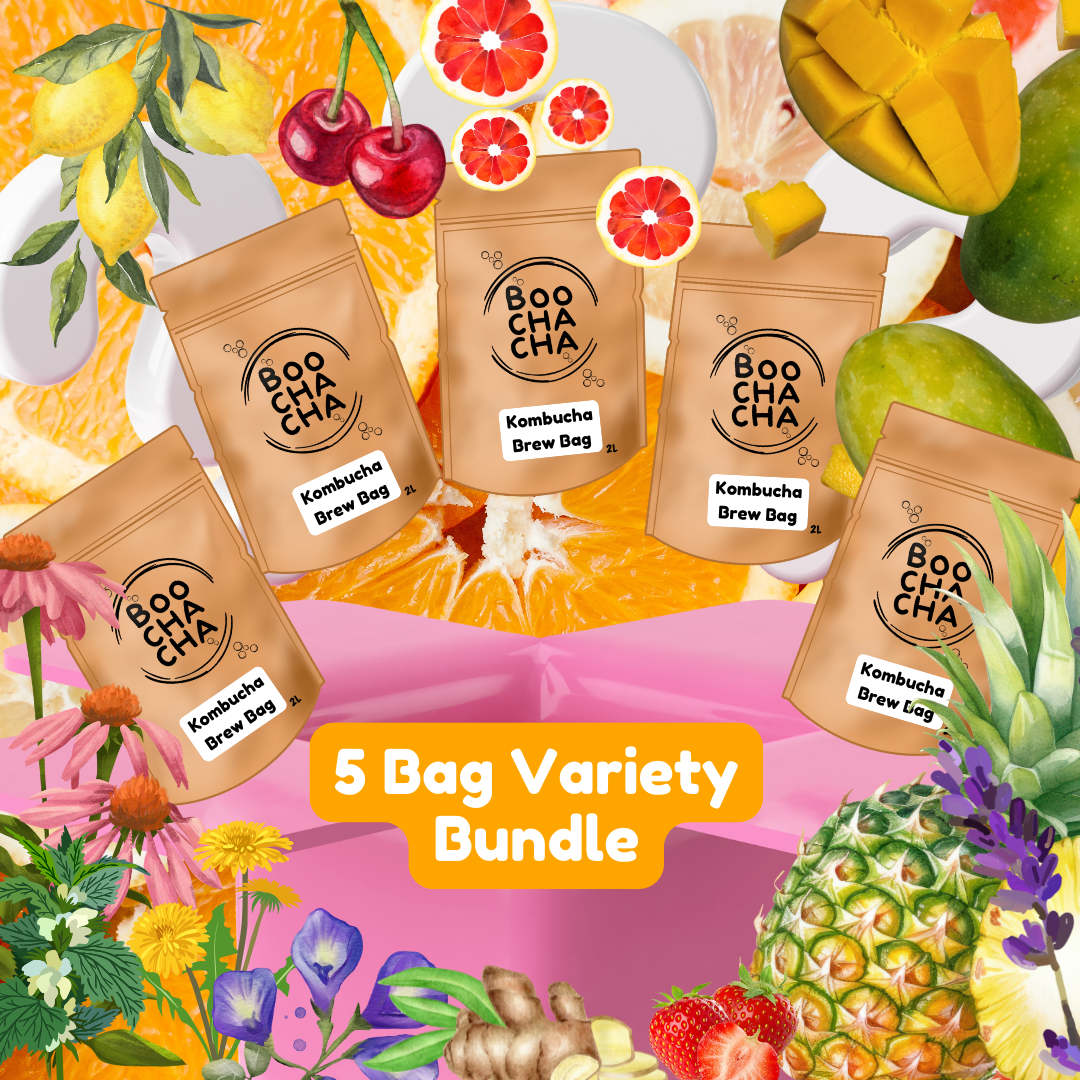Why does all* shop bought Kombucha contain caffeine?
*we're talking about real, authentic Kombucha only here. The kind that has actually been through an authentic fermentation process (starts out as sweet tea, 7 - 10 days later it becomes Kombucha).
In case you're new here, Kombucha is a fizzy, fermented health tonic that’s known for its tarty kick and probiotic benefits. Traditional Kombucha is brewed using black or green tea, or a mix of the two, so it naturally contains caffeine, which isn’t ideal for everyone.
Whether you’re cutting back on caffeine, avoiding it for health reasons, or looking for a more kid-friendly version, the good news is: yes, you can absolutely brew your own low-caffeine or even caffeine-free Kombucha at home.
In this post, we’ll go through more about why Kombucha usually contains caffeine, how much typically, how to lower or eliminate it, and some great low-caffeine recipe combinations to try in your own brewing setup.

So the short story is, if you want Kombucha with low, or no caffeine, then you better start brewing your own!
Our famous Kombucha Starter Kits are the best way to get started with brewing Kombucha at home. We always include green tea brew bundles, which helps keep the caffeine of your Kombucha low, but also packs a load of anti-oxidants in!
Why Kombucha Contains Caffeine in the First Place
To understand how to make low-caffeine Kombucha, it helps to know why there’s caffeine in it at all.
Kombucha is traditionally brewed with tea from the Camellia sinensis plant, which includes black tea, green tea, white tea, and oolong.
These teas all naturally contain caffeine. When sugar and tea are combined and fermented with a SCOBY (Symbiotic Culture of Bacteria and Yeast), the result is Kombucha.

But here’s the thing: the SCOBY doesn’t require caffeine to survive. It thrives on sugar and nutrients, and while some argue that caffeine provides trace minerals that may help fermentation, many brewers (us included) have successfully used herbal and low-caffeine alternatives.
What’s important is creating the right balance for the microbes and flavours to thrive.
Does Fermentation Reduce Caffeine?
Yes, but only a little. Some caffeine is broken down during fermentation, so finished Kombucha generally has less caffeine than the tea it started with.
On average, a 250ml serving of black-tea-based Kombucha might have 10 - 20 mg of caffeine, compared to 40 - 60 mg in a cup of black tea.
A green-tea-based Kombucha might have 5 - 15mg of caffeine compared to 25 - 45 mg in a cup of green tea.
For comparison, a cup of drip coffee tends to have 90 - 120 mg per 250ml.
So if you want to start with a lower caffeine load, the best way is to use low- or no-caffeine teas in your brew from the beginning.
We start all of our customers off with green tea Kombucha brew bundles, which means we give the SCOBY plenty of nutrients to grow in its first two brews, but it also means you brew a Kombucha with a slightly lower caffeine level.
How to Make Low-Caffeine Kombucha
There are two options for lowering the caffeine in your Kombucha brew:
- Use low-caffeine teas like green tea, white tea, or even some decaffeinated teas
- Use caffeine-free herbal teas as part or all of your blend
The most important thing to remember is that your SCOBY still needs nutrients.
Completely removing real tea can make your culture weaken over time unless you maintain a healthy mix of nutrients in your brewing cycle.
It is important to note that all SCOBYs will most likely be grown using a caffeine based tea (usually green or black) and so the starter liquid it comes in, will contain a small amount of caffeine. This starter liquid makes up between 10-20% of your brew in total, so in the end this amount will be very low.
Many brewers use a combination of herbal and real tea to strike the balance between flavour, nutrients, and low caffeine content.
We have low and no caffeine blends in our huge range of Kombucha Brew Bags, which we are constantly updating with new releases and seasonal specials!
The Best Low-Caffeine and Caffeine-Free Teas for Kombucha
Here are some low or no caffeine options that work beautifully when making Kombucha:
- Rooibos: Naturally caffeine-free and full-bodied with a red tea flavour. Rooibos works well as a primary tea or blended with white or green tea.
- Hibiscus: Tart, vibrant, and rich in vitamin C. Use in small amounts or mix with a milder tea to avoid overpowering your brew.
- Chamomile: Mild, floral, and calming. Best used as part of a blend for a gentle flavour profile.
- Peppermint, Lemongrass or lavender: Fresh, clean, and bright. Great in small amounts to add complexity in blends but not ideal as a standalone base.
- Decaffeinated Green or Black Tea: Retains the structure of true tea but without the caffeine. Choose naturally decaffeinated (water-processed) teas if possible.
-
White tea: Very low in caffeine and gentle in flavour. It’s a great base for those wanting a subtle profile.
How to Make Caffeine Free Kombucha
As we explained above, all Kombucha starter cultures (SCOBYs and starter liquid) will contain caffeine, as they will be made with traditional teas.
The best idea for anyone who wants to make Kombucha with as low caffeine as possible (will eventually be caffeine free) is to get yourself a starter culture and start brewing with a caffeine free blend (check out our caffeine free Kombucha brew bags here).
As you make batch after batch, the caffeine will become further and further diluted, and will eventually become so low it will count as caffeine free.
The important thing to remember with Kombucha, is to be patient. Allow your brew time to build acidity, and to get that tart kick, as that will keep the fermentation lively from brew to brew. Rooibos Kombucha can take a few extra days to lose the sweetness simply because the flavour of the tea itself is quite fruity, so just keep that in mind.
Anyone who already has a continuous brew set-up could use a spare SCOBY with some starter liquid to get a second brew going dedicated to making low or no caffeine Kombucha.
Kombucha Brewing Beginners
If you're starting out brewing Kombucha, we always recommend getting used to the taste of your homemade Kombucha, and the way your SCOBY grows when it is fed real tea.
This is why we include two green tea brew bundles (ingredients for your first 2 batches of Kombucha) in all of our starter kits, but after you have done you first 2 brews, you can then start the experiments with different tea blends (make sure to browse our range of Kombucha Brew Bags here)!
It is worth noting that your starter liquid, that always comes with your SCOBY, will be brewed with traditional teas that contain caffeine.
We have a free guide here on how to get started with your own Kombucha brew at home.

Flavouring Ideas for Low-Caffeine Kombucha (Second Ferment)
Here’s where the fun starts!
After the first ferment, you can add your brewed Kombucha into bottles, add your favourite ingredients, and even get a good fizz (more on that here).
Try these delicious low-caffeine-friendly combinations:
White Grape & Chamomile
Add 2 tablespoons of white grape juice and a few dried chamomile flowers. Will work great with brews based on a green tea. Tastes like a delicate white wine!
Apple Pie Booch
Add 3 slices of apple, a pinch of cinnamon, and a small piece of vanilla bean. Works with green tea or rooibos tea base.
Berry Hibiscus Fizz
Add a few frozen raspberries and a teaspoon of dried hibiscus petals. This works AMAZINGLY with a rooibos tea base.
Lemon & Ginger
Add a slice of fresh ginger and 1 teaspoon of lemon juice or zest. This flavour combo works great with any tea base!
Peach Mint Cooler
Add 2 slices of fresh peach and a few mint leaves. Works great with peppermint and green tea base.
Lavender Lemonade
Add ½ teaspoon dried lavender and 1 teaspoon lemon juice. Works great with rooibos or green tea base.
Let the bottles ferment at room temperature for 2–4 more days (burp daily to release pressure), then refrigerate and enjoy cold.

Keeping Your SCOBY Healthy on a Caffeine-Free Diet
If you're making continuous batches without any traditional tea, be aware that your SCOBY may eventually weaken (this is very common advice in the Kombucha world, but you can read a lot about people who have been using only rooibos or hibiscus tea to brew their Kombucha successfully for years, so it is possible that the 'real tea' information is a myth) but do look out for signs of weakness, such as; very slow fermentation (rooibos tea can be slightly slower anyway), layers of the SCOBY growing very thin, looking see through, or not growing new layers at all.
If you start to see signs of weakness, simply brew the next batch of Kombucha with some green or black tea mixed in (we have some mixed Kombucha brew bags too). These blends will give your SCOBY some nutrients, and help keep the brew low caffeine too.
We are doing our own experiments, but this will take time, so for now we've been reading A LOT on Reddit forums!
Here are a few tips to keep your culture thriving:
- Use decaf tea made with the water process (not chemical decaf), which retains more nutrients
- Add a small amount of regular tea into your blend every few batches to boost minerals
- Watch for signs of SCOBY distress like sluggish fermentation, or off smells
- Rotate in healthy starter liquid every 3 - 5 ish brews if not using a small amount of regular tea in your blends every few batches
If you're brewing for kids or caffeine-sensitive people, it’s worth rotating between mildly caffeinated (like green or white tea) and full herbal blends to keep the brew active while staying low in caffeine.
Can You Buy Caffeine-Free Kombucha?
In the world of real* Kombucha, the answer to this must be a no, because the starter liquid is almost surely always brewed with traditional tea. If a commercial company then brew with a caffeine free tea, as time goes on the caffeine in the Kombucha will become very low (and possibly completely disappear) but I am unaware of any companies doing this (yet).
I am not including Kombucha which is made using a powdered substrate, or sold in powders, which hasn't been through a traditional fermentation process (these may claim to be caffeine free).
Brewing your own at home gives you total control over the tea, sugar, flavour, and caffeine level. Plus, it’s more fun and cost-effective!
Making low- or no-caffeine Kombucha at home is totally doable and incredibly rewarding. By experimenting with herbal teas and low-caffeine options like green, white tea or rooibos, you can create flavourful, probiotic-rich drinks without the buzz.
It’s also a great option for introducing kids to Kombucha, or for sipping in the evening when you want something fun and fizzy without messing with your sleep.
Once you get the hang of it, you’ll be able to create your own blends, flavour profiles, and seasonal combos that taste just as exciting as the store-bought stuff, minus the caffeine jitters.
Want to get started the easy way? Try our Complete Kombucha Starter Kit, which includes everything you need to begin brewing at home, and bookmark this blog to get started with your caffeine free recipes.




